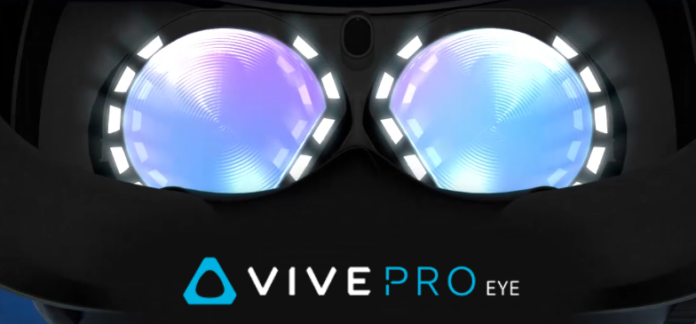HTC made a surprise announcement at CES 2019, but its Twitter account hinted at big things to come. We think the company had a big year this year, even if the buzz is all over Oculus’ Quest visor. HTC, meanwhile, was unveiling ProEye. The upgrade to the Pro has built in eye tracking, and they demoed the device with MLB Homerun Derby.
The device has some neat hardware and specs running under the hood, and it’s clear HTC is aiming for a premium market, but eye tracking is a big deal for VR Fitness.
It’s not just about how your PC utilizes resources. Eye tracking opens up a new world of interaction, from menus navigated by sight to more interesting and physical use cases. Here’s a breakdown of HTC’s big announcement.
Pro Eye Specs
Pro Eye is built for professionals, and the high-end specs speak to that. LED sensors around the eyes track where your eyes are looking in VR, not just your head movements. Your eyes become an intuitive type of control for the experience, which is especially useful in situations requiring quick reactions.

You can find a good example in QuiVR, and it will be familiar to anyone who has played the game. If you’ve ever felt like you are looking right at the target and missing by just a few inches, eye tracking would help. The ProEye will zero in on that target and the arrow will travel where the user is looking. It’s not really assistive aim, more intuitive aim.
But what you’re not focusing on is just as interesting. The ProEye uses foveated rendering, a concept we’ve written about before but bears repeating. It’s a pretty cool piece of technology that renders what you’re looking at in high definition. The area around you, in your peripheral, is blurred out or lower in resolution, allowing your entire system to run more efficiently. You don’t notice the lower resolution, and the game dynamically renders the environment as necessary.
HomeRun Derby and Eye Tracking
When HTC unveiled the device, they needed a practical showcase for its capabilities. Homerun Derby uses eye tracking for menu navigation, and let’s face it, every coach ever has told players to “keep your eyes on the ball”. That adage actually applies now.
Foveated rendering creates a kind of focus on the ball as it approaches, so your swing feels more precise. The perfect connection, or at least as perfect as feels right to you. Homerun Derby has been criticized in the past as being too arcade-like, or too fast paced. With eye tracking, the game has the potential to be less whack-a-mole and just a bit more instructive.
HTC and Pushing VR Forward
HTC has done a lot to push the VR platform forward. Its Viveport marketplace may not be desirable for fitness fans just yet, but it is expanding and new games are added all the time. The company, meanwhile, continues to manufacture top-of-the-line VR headsets. The ProEye also expands the available playspace up to 15×15 feet. This is huge for arcades and high-end studios, which often have dedicated playspaces for VR.

ProEye may be aimed at the highest end of the VR market, but we all benefit from new technology in VR. Enthusiasts get a brand new platform to toy with and more casual users get more accessories and more affordable options.
CES 2019 did a great job establishing VR as a serious and growing platform. The ProEye shows what the top end of that looks like, but plenty of opportunities exist in between.


